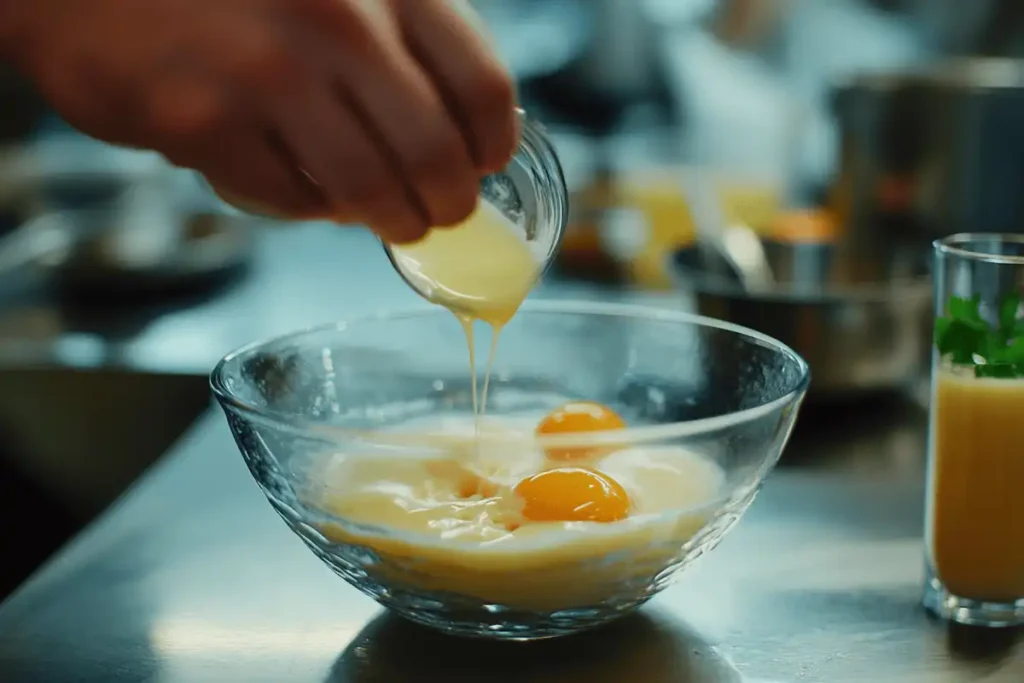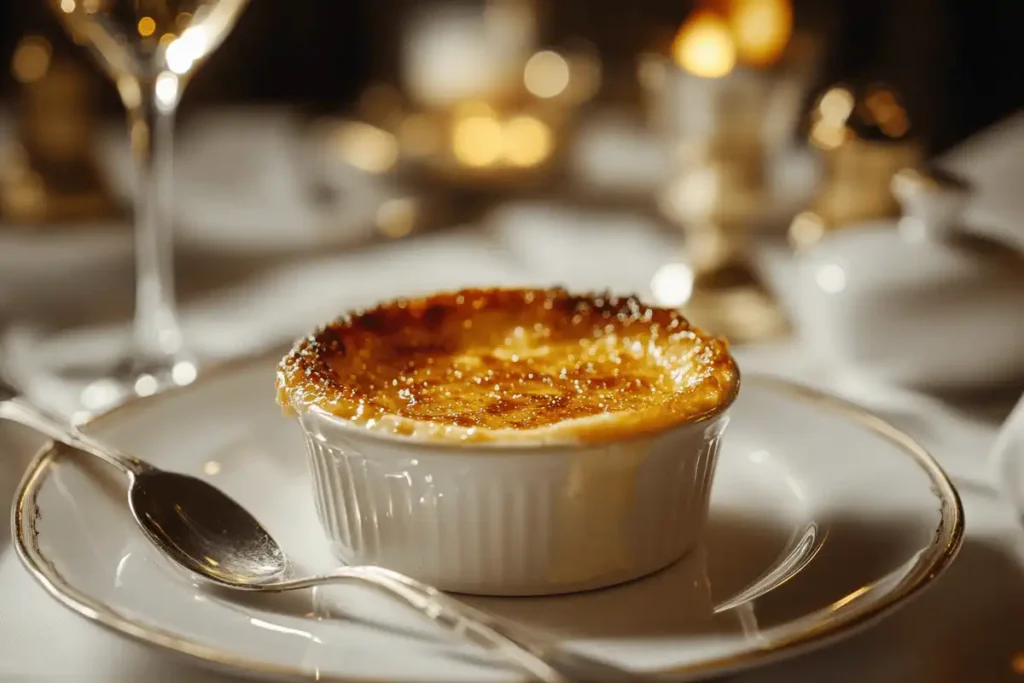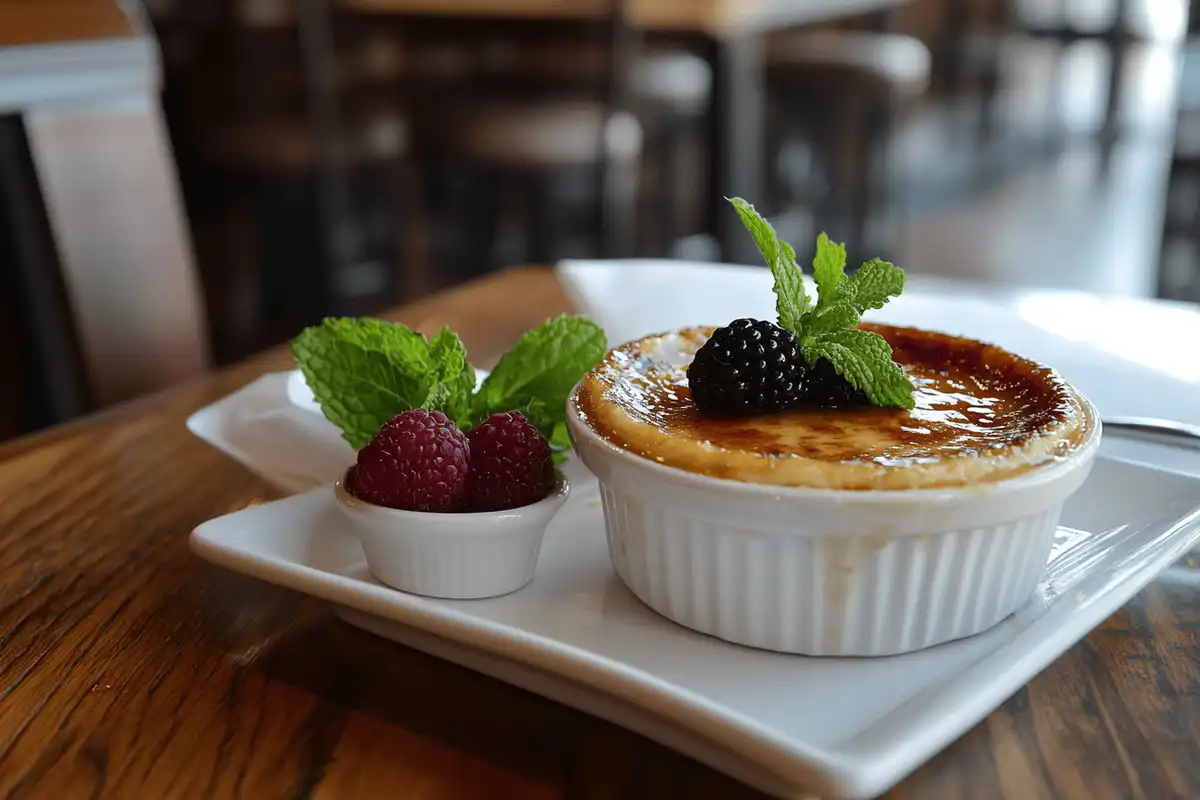Crème brûlée, a dessert that combines a luscious custard base with a crispy caramelized topping, is the epitome of culinary elegance. Its name, which translates to “burnt cream,” perfectly captures its signature look and taste. This article explores what crème brûlée is mostly made of, diving into its core ingredients, preparation techniques, and the creative variations that make this dessert a timeless classic. From understanding the culinary techniques to mastering the perfect ingredient proportions, this guide will ensure you can recreate this beloved dish in your kitchen.
Let’s begin by introducing the essential elements that make up this dessert.
Introduction to Crème Brûlée
What is Crème Brûlée?
Crème brûlée is more than just a dessert; it’s a sensory experience. At its core, this dish features a silky, custard-like base infused with rich flavors, typically vanilla. The highlight, however, is its caramelized sugar crust—a thin layer of sugar melted to perfection, creating a delightful crunch with every bite. This contrast between the smooth custard and the crisp top has made it a favorite in fine dining and home kitchens alike.
Its simplicity is part of its charm. Made from just a few ingredients—heavy cream, egg yolks, sugar, and vanilla extract—crème brûlée embodies the concept of “less is more.” The secret lies in the precision of its preparation, as even minor deviations can affect the outcome.
The Popularity of Crème Brûlée Across Cultures
Though it has its roots in French cuisine, crème brûlée’s appeal knows no borders. It has been adopted and adapted across cultures, each adding a unique twist. Whether it’s served with a splash of citrus, infused with coffee, or accompanied by fresh berries, this dessert continues to evolve while staying true to its classic form.
From its debut in royal kitchens to its place on Michelin-starred menus, crème brûlée remains a beloved treat worldwide. Its enduring popularity is a testament to the universal love for creamy, caramelized desserts.
The Core Ingredients of Crème Brûlée
Crème brûlée’s magic lies in its simplicity. Each ingredient plays a crucial role, coming together to create the iconic creamy texture and crisp topping. Let’s break down what crème brûlée is mostly made of.
Heavy Cream: The Rich Foundation
At the heart of crème brûlée is heavy cream, responsible for its indulgently rich texture. The cream forms the base of the custard, delivering smoothness and an unmistakable velvety mouthfeel. Its high fat content is crucial to achieving that signature creaminess. For a detailed exploration of cream options, check out What Type of Cream is Best for Crème Brûlée?.
Egg Yolks: Adding Structure and Texture
Egg yolks are the unsung heroes in this dessert. They bind the custard, adding a luxurious thickness and depth of flavor. By only using yolks, crème brûlée avoids becoming overly dense. The gentle cooking process preserves the creamy consistency, ensuring that the yolks shine as the backbone of this treat.
Sugar: Dual Roles in Sweetness and Caramelization
Sugar plays a double act in crème brûlée. In the custard, it sweetens the dessert, balancing the richness of the cream and egg yolks. On top, sugar transforms into the dish’s iconic caramelized crust. Using a kitchen torch to achieve the perfect golden brown topping elevates the experience. Want tips for mastering this step? Read What is the Secret to Crème Brûlée?.
Vanilla Extract: The Quintessential Flavor
Vanilla extract gives crème brûlée its timeless flavor. Whether from pure vanilla pods or high-quality extract, the aroma complements the custard’s richness. Some adventurous chefs experiment with alternatives like almond or coffee flavors, but classic vanilla remains the crowd favorite.
The Perfect Ratios and Measurements
Precision is the key to creating a flawless crème brûlée. Understanding the balance between cream, eggs, and sugar ensures a dessert that’s creamy yet stable, sweet but not cloying. Let’s explore these crucial proportions.
Understanding the Cream-to-Egg Yolk Ratio
The ratio of cream to egg yolks determines the custard’s texture. Typically, a higher ratio of cream produces a softer, silkier custard, while too many egg yolks risk a rubbery consistency. Most recipes recommend a ratio of 4 parts cream to 1 part egg yolks, ensuring the perfect balance.
Balancing Sugar in Custard and Topping
Sugar isn’t just for sweetness—it also affects texture. In the custard, just enough sugar is added to enhance flavor without overpowering the creamy base. For the topping, a thin layer of granulated sugar caramelizes into a crispy crust, creating a delightful contrast to the soft custard beneath.
Why Precision Matters in Crème Brûlée Recipes
Small mistakes in measuring ingredients can drastically alter the final product. Adding too much sugar, for instance, can make the custard overly sweet, while skimping on cream affects its texture. Using a scale or precise measuring cups ensures accuracy, and following recipes to the letter guarantees success.
Step-by-Step Guide to Making Crème Brûlée
Perfecting crème brûlée requires attention to detail and a bit of patience. The process may seem daunting at first, but with the right approach, you’ll achieve that silky custard and caramelized sugar topping every time. Here’s how to make the magic happen.
Preparing and Combining Ingredients
Start by gathering the core ingredients: heavy cream, egg yolks, sugar, and vanilla extract. Gently heat the cream with vanilla to infuse it with flavor—don’t let it boil. In a separate bowl, whisk the egg yolks and sugar until pale and slightly thickened. Gradually pour the warm cream into the egg mixture, whisking constantly to prevent curdling.
Strain the mixture through a fine sieve to remove any lumps, ensuring a smooth custard. This step is crucial for a luxurious texture.

The Role of a Water Bath in Baking
To achieve the perfect custard consistency, crème brûlée must be baked in a water bath. Place your ramekins in a deep baking dish and pour the custard into each. Fill the dish with hot water until it reaches halfway up the sides of the ramekins. This technique ensures even cooking by preventing the custard from overheating.
Bake at a low temperature (typically around 325°F/160°C) until the custard is set but still jiggly in the center. Overbaking can lead to a grainy texture, so keep a close eye.
Caramelizing the Sugar Topping for a Crisp Finish
Once the custard has cooled and set, it’s time for the pièce de résistance: the caramelized topping. Sprinkle an even layer of granulated sugar over each custard. Using a kitchen torch, melt the sugar until golden brown and crisp. If you don’t have a torch, use the oven’s broiler function, but watch closely to avoid burning.
For an in-depth look at achieving the perfect caramelization, you might enjoy reading What is the Secret to Crème Brûlée?.
Variations of the Classic Recipe
While the traditional crème brûlée recipe is a masterpiece, adding a personal twist can elevate this dessert to new heights. Whether you’re experimenting with flavors, toppings, or ingredients, there are endless ways to make this dish your own.
Experimenting with Different Flavors
Infusing the custard with alternative flavors can create an entirely new experience. Popular options include:
- Citrus zest for a refreshing tang.
- Espresso for a bold, coffee-infused twist.
- Almond or hazelnut extract for nutty undertones.
These variations complement the dessert’s creamy texture while adding a unique flair.
Alternative Toppings to Elevate Your Dessert
While the classic caramelized sugar topping is iconic, don’t hesitate to experiment. Try a sprinkling of brown sugar for a deeper molasses flavor, or add shredded coconut, fresh berries, or even crushed nuts for an additional layer of texture and taste.
Using Dairy Alternatives: Pros and Cons
For those seeking lighter options, swapping heavy cream for alternatives like coconut cream or a mix of cream and milk can work. However, be mindful that this may alter the dessert’s signature creaminess. Precision and careful adjustment of proportions are key to maintaining balance.
For more inspiration, consider checking out other dessert recipes on the website to find ideas for your next culinary adventure!
The Culinary Significance of Crème Brûlée
Crème brûlée isn’t just a dessert—it’s a symbol of sophistication and timeless culinary artistry. Its rich history and continued popularity showcase why it’s treasured by chefs and food lovers alike. To truly appreciate this dish, understanding its cultural and historical significance is essential.
The History of Crème Brûlée
Crème brûlée traces its origins back to France, where it first gained recognition in the 17th century. The dessert’s name, which translates to “burnt cream,” describes its caramelized sugar topping—a hallmark of its elegance. Over time, it became a staple in French fine dining, admired for its simple yet luxurious composition.
Interestingly, other countries have their own interpretations of similar desserts, like Spain’s crema catalana and England’s Trinity cream. Despite these variations, crème brûlée remains the quintessential version, celebrated worldwide.

Why It’s a Timeless Classic in French Cuisine
Few desserts capture the balance of simplicity and decadence as perfectly as crème brûlée. Its universal appeal lies in its velvety custard base and crisp, caramelized topping. The ability to personalize the dish with subtle variations ensures its place in both traditional and modern culinary repertoires.
From intimate dinners to grand celebrations, crème brûlée graces tables as a testament to French culinary excellence. Its staying power stems not only from its irresistible taste but also from the meticulous care required to prepare it.
Frequently Asked Questions (FAQs)
If you’re curious about what crème brûlée is mostly made of or have questions about its preparation, these answers will help clarify.
What Type of Cream Is Best for Crème Brûlée?
Heavy cream is the ideal choice for crème brûlée, thanks to its high fat content. It creates the smooth, rich texture that defines the dessert. Lower-fat alternatives may compromise the creaminess.
Can You Use Milk Instead of Cream?
While it’s possible to substitute milk, it’s not recommended. Milk lacks the fat needed to produce the velvety custard texture, which is a hallmark of crème brûlée.
Why Is a Water Bath Necessary?
A water bath ensures even cooking by surrounding the ramekins with gentle heat. This method prevents the eggs in the custard from curdling and guarantees a smooth result.
How Do You Achieve a Perfect Caramelized Top?
To get that classic caramelized top, evenly sprinkle sugar over the custard and use a kitchen torch to melt it until golden brown. Alternatively, use a broiler, but keep a close eye to avoid burning.
For more tips and tricks on making crème brûlée, check out other dessert recipes to refine your skills and explore variations!
Exploring Ingredient Quality
To truly master crème brûlée, it’s not just about the technique—it’s also about the quality of ingredients. Each component contributes significantly to the final result, making ingredient selection a crucial part of the process.
The Freshness of the Cream and Eggs
When considering what crème brûlée is mostly made of, heavy cream and egg yolks come to mind as the key ingredients. Using fresh cream ensures a rich, smooth texture, while fresh eggs provide structure and enhance flavor. Always check expiration dates and store ingredients properly to maintain their quality.
Fresh eggs not only improve the custard’s consistency but also enhance its overall taste. Similarly, high-quality heavy cream guarantees the velvety mouthfeel that crème brûlée is known for.
The Impact of Vanilla Extract Quality
Vanilla extract might seem like a minor detail, but its quality has a significant impact on the dessert’s flavor profile. Pure vanilla extract or vanilla bean paste adds a natural, aromatic depth that artificial substitutes simply can’t match. For an elevated experience, consider using whole vanilla pods for a more intense flavor.
By prioritizing high-quality ingredients, you’ll elevate your crème brûlée from a good dessert to a spectacular one. When every component shines, the final dish becomes a culinary masterpiece.
Conclusion
Crème brûlée is a dessert that captures the essence of simplicity and elegance. When exploring what crème brûlée is mostly made of, we find that just a handful of ingredients—heavy cream, egg yolks, sugar, and vanilla extract—are transformed into a timeless treat.
The magic of crème brûlée lies in the harmony of its creamy custard base and crisp caramelized top. By understanding the roles of each ingredient and perfecting techniques like the water bath and caramelization, you can recreate this classic dessert with confidence.
Precision and quality are your allies in this journey. Fresh ingredients and attention to detail ensure your crème brûlée stands out. From experimenting with flavors to mastering traditional techniques, the possibilities for personalization are endless.
So, whether you’re making crème brûlée for a special occasion or a casual dinner, this dessert promises to impress. It’s not just a dish—it’s an experience, rich in history and flavor.
Now, armed with knowledge and inspiration, it’s time to roll up your sleeves and bring this culinary masterpiece to life in your kitchen. Indulge in the creamy, caramelized delight that is crème brûlée, and share its magic with those around you!

